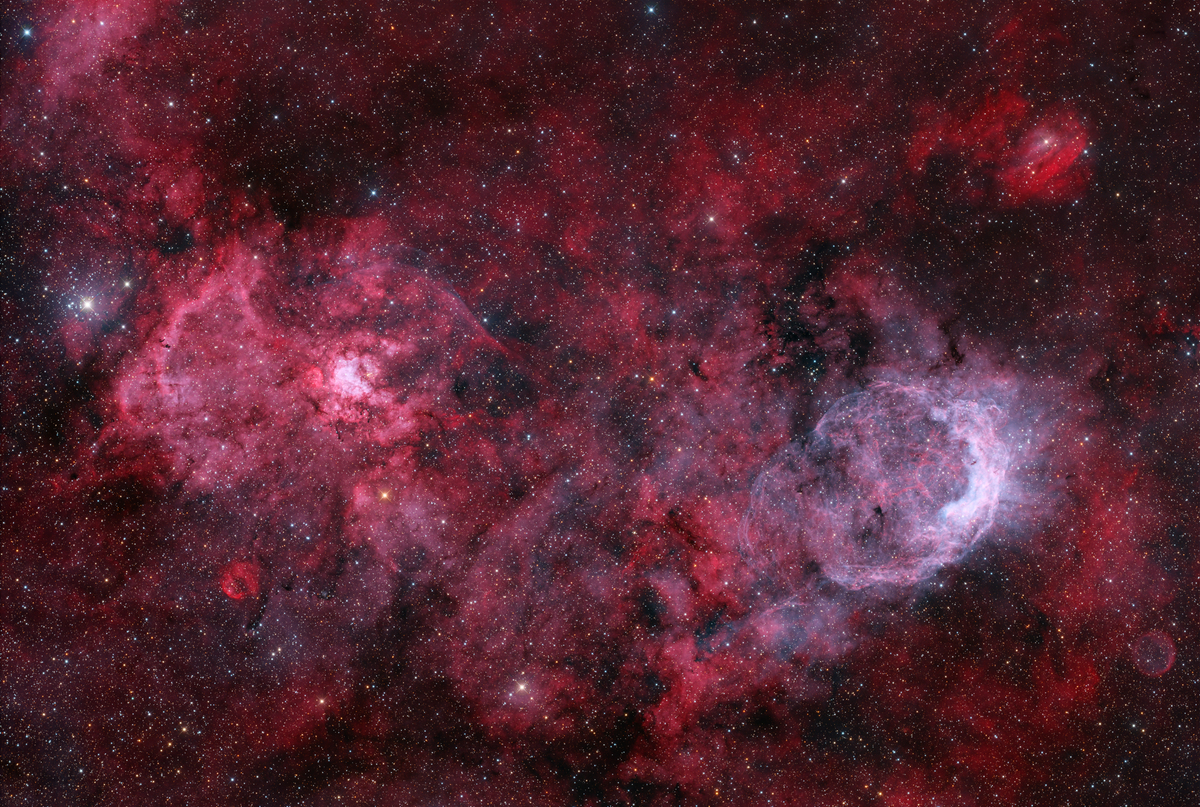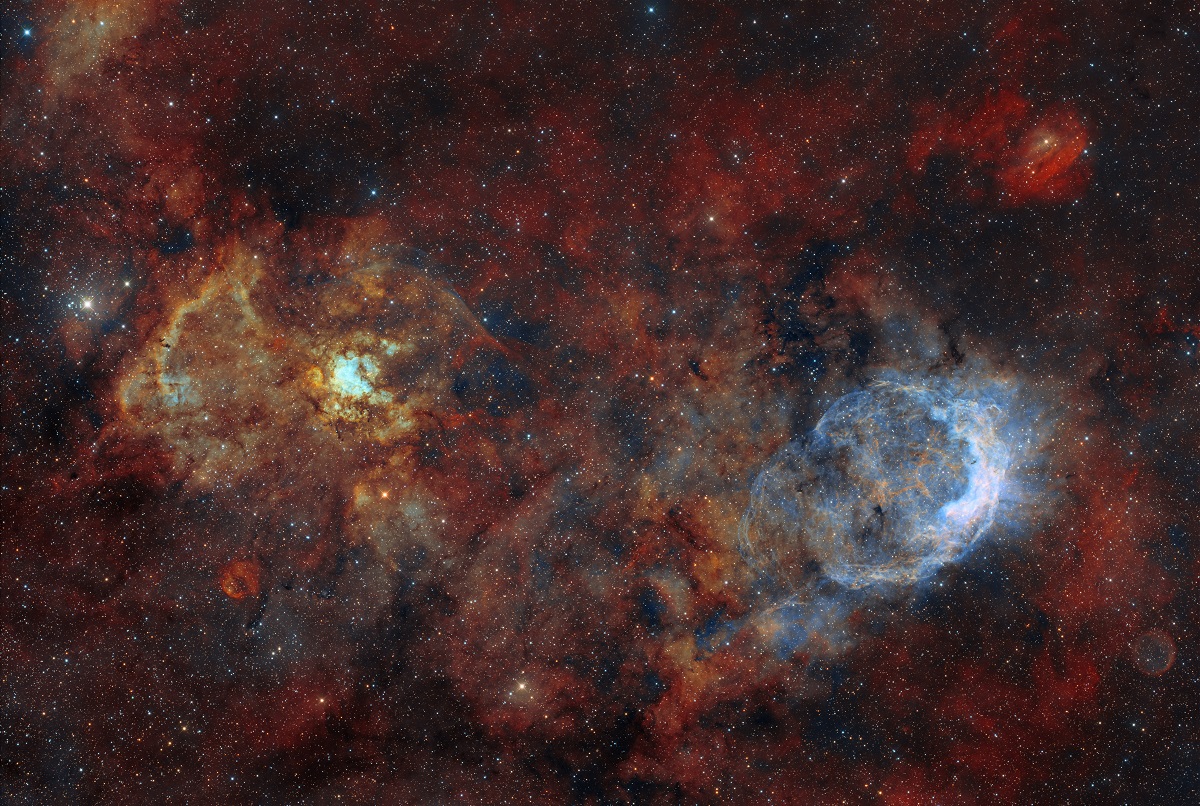
[back] NGC 3199 & RCW 49 in Carina
100%
image RGB-version / 100% Bild RGB-Version (9407 x 6326, 0.743"/pixel)
100%
image SHO-version / 100% Bild SHO-Version (9407 x 6326, 0.743"/pixel)
100%
image SHO-Foraxx-version / 100% Bild SHO-Foraxx-Version (9407 x 6326, 0.743"/pixel)
Annotated 100%
image / Beschriftetes 100% Bild (9407 x 6326, 0.743"/pixel)

|
(c) 2025 All astro photo images are copyrighted. They may not be used or reproduced without explicit written permission from the authors. |
|
300" |
|
SHO-Foraxx-Version

|
(c) 2025 All astro photo images are copyrighted. They may not be used or reproduced without explicit written permission from the authors. |
|
300" |
|
About this Image / Über dieses Bild
| Camera: | Moravian C3-PRO-61000 Mono CMOS |
| Image Type, Orientation: | RGB-and SHO Color Composite, North is at 12:00 |
| Exposure time: | RGB: 21/20/20 x 300s, SII: 17 x 900s, H-alpha: 16 x 900s, OIII: 18 x 900s (total 17:50h) |
| Exposure date: | May 30th... June 31st, 2025 |
| Location: | Capella Observatory South at Kiripotib Astro Farm, Namibia |
| Filter: | Astronomik Deep-Sky Deep-Sky RGB Filter plus 6nm Ha filter on Moravian EFW-3L-9-II External Filter Wheel |
| Instrument: | "Rhea", a PlaneWave DeltaRho 350, 1050mm focal length, 350mm aperture, f/3 on 10Micron GM2000 HPS II Combi |
| Photographer: | Rainer Raupach, Josef Pöpsel, Frank Sackenheim, Stefan Binnewies |
| Remarks: |
NGC 3199 is an emission nebula located in the
constellation Carina. Its brighter region, dominated by H-alpha emission, is
also cataloged as RCW 48. The ionization is driven by the Wolf–Rayet star WR
18. While most images reveal only an arc-shaped structure, deep exposures
obtained with the Rhea telescope reveal the complete spherical shock front,
displaying intricate filamentary structures in all imaged emission lines —
[S II], H-alpha, and [O III]. On the eastern side of the field lies the H II region and star-forming complex RCW 49, whose ionization source is the OB association NGC 3247. At the periphery of RCW 49 sits the star cluster Westerlund 2, partly obscured by dark nebulae. This is a compact, young cluster — possibly a so-called super star cluster — with an estimated age of only one to two million years. It hosts some of the hottest, most luminous, and most massive stars known. Several O-type stars have not yet reached the main sequence; at least three of these form eclipsing binary systems. Due to interstellar extinction, the young stars appear heavily reddened rather than blue. The vicinity of Westerlund 2 contains multiple Wolf–Rayet stars thought to be “runaways,” dynamically ejected from the cluster. Notably, WR 20a is a binary system consisting of two orbiting WR stars of type O3If*/WN6, with an orbital period of just 3.7 days. By contrast, the more easterly WR 21a is believed to be unrelated to Westerlund 2. Also noteworthy are the planetary nebula PN MeWe 1-2, located in the southwestern corner of the field, and the pre-planetary nebula Roberts 22 in the southern central region, recognizable as a small bipolar structure. The image was processed in three distinct versions: a near-true-color rendering approximating the visual impression, a classical Hubble palette version, and a Foraxx palette version. |
|
|
|
| Bemerkungen: |
NGC 3199 stellt ein
Emissionsnebel im Sternbild Carina dar, wobei der hellere Bereich mit
vorwiegend H-alpha Emission auch als RCW 48 bezeichnet wird. Ursprung der
Ionisation ist der Wolf-Rayet-Stern WR 18. Während auf den meisten Bildern
nur eine bogenförmige Struktur dargestellt wird, zeigt sich bei der tieferen
Belichtung mit Rhea die komplette sphärische Schockfront mit interessanten
Filament-Strukturen in allen aufgenommenen Emissionslinien SII, H-alpha und
OIII. |
|
|
|
| References: |
[1] Melmer + Weinberger catalog: MeWe 1-x
(N=11 entries), 1990:
https://simbad.cds.unistra.fr/simbad/sim-ref?bibcode=1990MNRAS.243..236M [2] Mon. Not. R. astr. Soc. (1978) 184, 601-610: https://simbad.cds.unistra.fr/simbad/sim-ref?bibcode=1978MNRAS.184..601A |
Back to the Diffuse Nebulae Overview / Zurück zur Diffuse-Nebel-Übersichtsseite